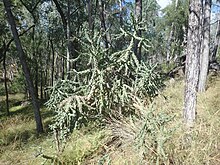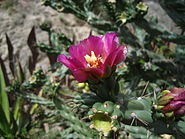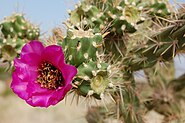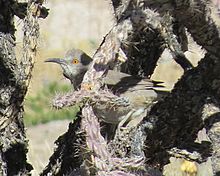| Cylindropuntia imbricata | |
|---|---|

| |
| Conservation status | |
 Least Concern (IUCN 3.1) | |
 Secure (NatureServe) | |
| Scientific classification | |
| Kingdom: | Plantae |
| Clade: | Tracheophytes |
| Clade: | Angiosperms |
| Clade: | Eudicots |
| Order: | Caryophyllales |
| Family: | Cactaceae |
| Genus: | Cylindropuntia |
| Species: | C. imbricata |
| Binomial name | |
| Cylindropuntia imbricata (Haw.) F.M.Knuth | |
| Subspecies | |
| |
| Synonyms | |
List
| |
Cylindropuntia imbricata, the cane cholla (walking stick cholla, tree cholla, or chainlink cactus), is a cactus found in the Southwestern United States and northern Mexico, including some cooler regions in comparison to many other cacti. It occurs primarily in the arid regions of the Southwestern United States in the states of Kansas, Oklahoma, Texas, New Mexico, Arizona, Colorado, and Nevada. It is often conspicuous because of its shrubby or even tree-like size, its silhouette, and its long-lasting yellowish fruits.
Distribution and habitat
The cane cholla's range is the arid regions of Nevada, Arizona, New Mexico, Colorado, Oklahoma, Kansas, and Texas, south to Durango, Zacatecas, and San Luis Potosí. It occurs at altitudes from 1,200 to 2,300 m (3,900 to 7,500 ft) and is hardy for a cactus (USDA Zone 5A).
In parts of its range, often just below the pinyon-juniper belt, it can be abundant, surrounded by low grasses and forbs that are brown most of the year; in such places chollas are conspicuous as the only tall green plant. Plants may form thickets or be spaced at a few times their width in "gardens".

This species is a noxious invasive in Australia in old mining localities and along watercourses. It is known there by the common names of Devil's rope cactus or Devil's rope pear. It is a declared noxious weed in New South Wales and also occurs in Queensland, Northern Territory, Victoria, and South Australia.
Description
 Cane cholla blossom
Cane cholla blossom
The above-ground part consists of much-branched cylindrical stems, the end joints being about 3 cm (1.2 in) in diameter. The joints, unlike those of some chollas, are hard to detach. The stems are highly tubercular (lumpy) with a pattern of long oval lumps. A typical height is about 1 m (3 ft), but exceptionally it can grow to 4.6 m (15 ft) with a "trunk" diameter of 25 cm (9.8 in). The width is often similar to or somewhat greater than the height. The stems are armed with clusters of up to about 10 red to pink spines, which may be 3 cm (1.2 in) long and are barbed and sharp enough to easily penetrate leather gardening gloves. The stems and fruits also have many spines or "glochids" about 1 mm (0.04 in) long that can detach and stick in the skin.
There are two kinds of stems or "cladodes": long plagiotropic, bearing flowers at the ends and falling off after a few years, and long orthotropic, primarily serving for support and transport and staying on the plant. Plagiotropic stems grow in a star- or crown-like pattern around a central orthotropic stem. This species blooms in late spring or early summer. The flowers are purple or magenta, rarely rose-pink, about 5 cm (2.0 in) wide. The fruits are yellowish, tubercular like the stems, and shaped something like the frustum of a cone, with a hollow at the wide end where the flower fell off; they are often mistaken for flowers. The plant retains them all winter. They are dry and not tasty, though the Indians of Arizona and New Mexico are said to have eaten them.
In addition to sexual reproduction, the tree cholla reproduces when stem joints fall to the ground and take root. Thus, this species spreads, and its spread is hard to control, especially where animals defecate seeds and carry stem joints stuck to their hide some distance from the parent plant. (Some cows, "cholla eaters", learn to eat cholla fruits despite the pain.) "Waves of invasion" typically occur four or five years after drought combined with grazing, probably because this combination exposes soil on which the stem joints can take root.
Taxonomy
Cylindropuntia imbricata was scientifically described as Cereus imbricatus by the botanist Adrian Hardy Haworth in 1821. Augustin Pyramus de Candolle moved it to Opuntia in 1828 and Joseph Paxton published it in Echinocactus in 1840. It was given its accepted placement in Cylindropuntia in 1930 by Frederik Marcus Knuth.
Ecology

The fruits are also eaten by various wild birds and mammals, including pronghorn, desert bighorn sheep, and deer. The thorny plants provide escape for cover for many small animals.
The leafcutter bee Lithurgus apicalis has been observed to pollinate the flowers.
Uses
The plants are sometimes grown as ornamentals. Dead stems decay to leave a hollow wooden tube with a pattern of lengthwise slits. These are sometimes used as canes or to make curios. The Roman Catholic Penitentes of New Mexico formerly tied fresh stems to their bare backs in Holy Week processions. The Zuni people use the imbricata variety ceremonially.
Images
-
 Flower
Flower
-
 Much yellow fruit at Parras De La Fuente, Cuahuila
Much yellow fruit at Parras De La Fuente, Cuahuila
-
 Fruits at Dolores Hidalgo, Guanajuato
Fruits at Dolores Hidalgo, Guanajuato
-
 At Salinas Pueblo Missions National Monument
At Salinas Pueblo Missions National Monument
-
 "Cane" (dried stem)
"Cane" (dried stem)
-
 In Illinois
In Illinois
-
In Albuquerque, New Mexico
References
- Hernández, H.M.; Cházaro, M.; Gómez-Hinostrosa, C. (2020) . "Cylindropuntia imbricata". IUCN Red List of Threatened Species. 2020: e.T152144A183111167. doi:10.2305/IUCN.UK.2020-3.RLTS.T152144A183111167.en. Retrieved 25 September 2024.
- NatureServe (2023). "Opuntia imbricata". Arlington, Virginia. Retrieved 23 December 2023.
- ^ "Cylindropuntia imbricata (Haw.) F.M.Knuth". Plants of the World Online. Royal Botanic Gardens, Kew. Retrieved 3 July 2024.
- Pinkava, Donald J. (2003). "Cylindropuntia imbricata". In Flora of North America Editorial Committee (ed.). Flora of North America North of Mexico (FNA). Vol. 4. New York and Oxford: Oxford University Press – via eFloras.org, Missouri Botanical Garden, St. Louis, MO & Harvard University Herbaria, Cambridge, MA.
- "Cylindropuntia imbricata". Germplasm Resources Information Network. Agricultural Research Service, United States Department of Agriculture. Retrieved 2007-03-13.
- ^ "Opuntia imbricata Chainlink Cactus". Garden Plants List. Horticopia, Inc. 2004. Archived from the original on 2006-11-06. Retrieved 2006-07-17.
- ^ "Devil's Rope Cactus". Weeds Australia. Australian Weeds Committee. Archived from the original on 13 April 2013. Retrieved 21 May 2012.
- ^ "Cylindropuntia imbricata". Australian Plant Name Index (APNI), IBIS database. Centre for Plant Biodiversity Research, Australian Government, Canberra. Retrieved 21 May 2012.
- "Cylindropuntia imbricata (Engelm.) F.M.Knuth". PlantNET - New South Wales Flora Online. Royal Botanic Gardens & Domain Trust, Sydney Australia. Retrieved 21 May 2012.
- ^ Johnson, F. L.; B. W. Hoagland (1999). "Opuntia imbricata (Haw.) DC". Catalog of the Woody Plants of Oklahoma: Descriptions and Range Maps. Oklahoma Biological Survey. Archived from the original on 2006-07-13. Retrieved 2006-07-17.
- ^ Elmore, Francis H. (1978). Trees and Shrubs of the Southwest Uplands. Western National Parks Association. ISBN 0-911408-41-X.
- Irish, Mary. "Handle With Care (Planting Cacti)". Learn2Grow. Archived from the original on 2009-10-23. Retrieved 2009-08-15.
- ^ Kunst, Carlos Roberto Guillermo (1990). Some autoecological aspects of Opuntia imbricata (Haw.) D.C. (cholla) (PhD). Texas Tech University. (title page). Archived from the original on 2011-08-15. Retrieved 2009-08-15.
- Lamb, Samuel H. (1975). Woody Plants of the Southwest: A Field Guide with Descriptive Text, Drawings, Range Maps, and Photographs. Sunstone Press. p. 34. ISBN 0-913270-50-4. Retrieved 2009-08-18.
These fruits are also safe for human consumption, with a sweet flavour and large seeds.
- Grant, Verne; Paul D. Hurd (1979). "Pollination of the southwestern Opuntias". Plant Systematics and Evolution. 133 (1–2): 15–28. Bibcode:1979PSyEv.133...15G. doi:10.1007/BF00985876. S2CID 42903463. (Subscription required.)
- Stevenson, Matilda Coxe 1915 Ethnobotany of the Zuni Indians. SI-BAE Annual Report #30 (p. 95)
| Taxon identifiers | |
|---|---|
| Cylindropuntia imbricata |
|
| Cereus imbricatus | |
- IUCN Red List least concern species
- NatureServe secure species
- Cylindropuntia
- Flora of the Chihuahuan Desert
- Flora of the Sonoran Deserts
- Cacti of the United States
- Cacti of Mexico
- Flora of Northeastern Mexico
- Flora of the Southwestern United States
- Flora of Coahuila
- Flora of Colorado
- Flora of Durango
- Flora of Kansas
- Flora of New Mexico
- Flora of San Luis Potosí
- Flora of Texas
- Flora of Utah
- Flora of Zacatecas
- North American desert flora
- Drought-tolerant plants
- Garden plants of North America